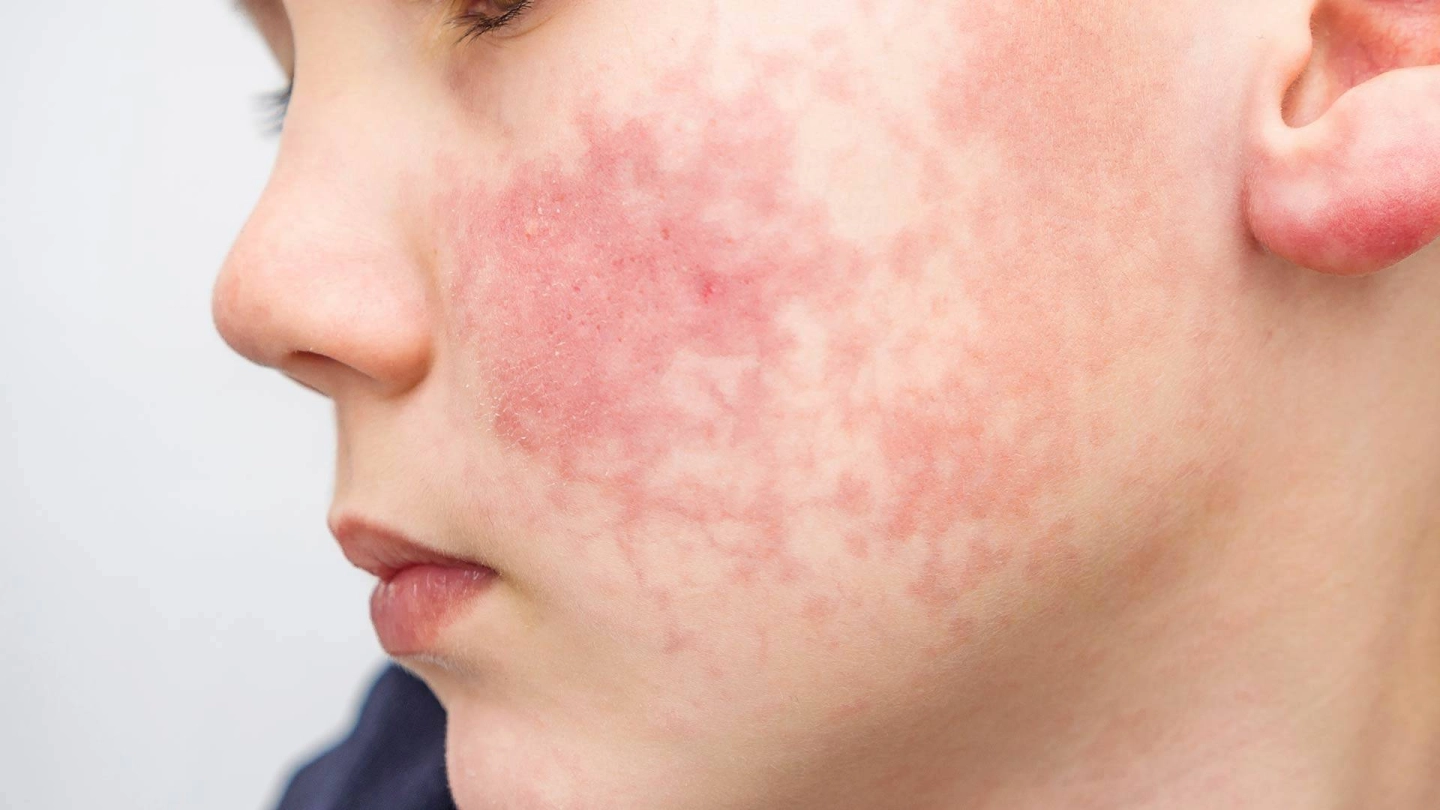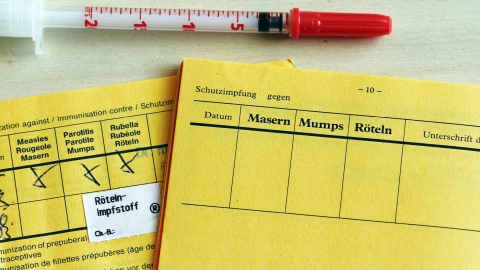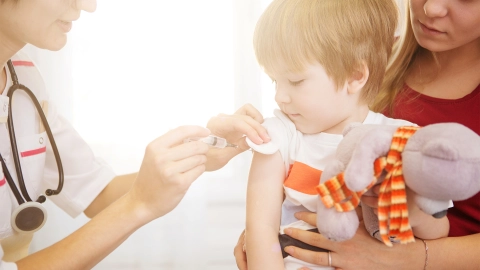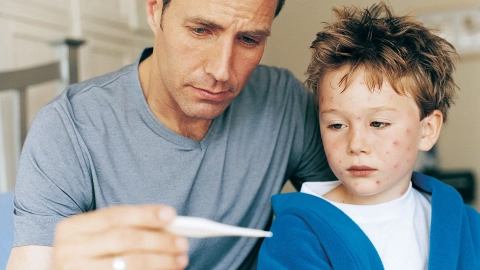Conditions Fifth disease
ICD codes: B08.3 What are ICD codes?
Fifth disease is a viral infection that is particularly common in children and is usually harmless. Infection leads to lifelong immunity. However, becoming infected while pregnant or with certain underlying conditions can have severe consequences.
At a glance
- Fifth disease is a common children’s illness that can also affect adults. Its name comes from the fact that, historically, it was fifth on the list of common rash-causing diseases in children. Fifth disease often goes unnoticed.
- It is caused by an infection with parvovirus B19, and is sometimes referred to as “parvovirus” or “parvovirus infection”.
- The typical symptom is a red rash on the skin of the face which can spread to the arms and upper body. This is the reason for the other name that is commonly used for this virus – “slapped cheek” or “slapped cheek syndrome”. In children, it is often accompanied by a high temperature.
- Once they have the rash, children with fifth disease are no longer infectious and they can attend kindergarten/pre-school or school as usual.
- When pregnant women are infected, the infection can harm the unborn child.
- There is no vaccine for fifth disease, but simple measures can provide protection against infection.
Note: The information in this article cannot and should not replace a medical consultation and must not be used for self-diagnosis or treatment.

What is fifth disease?
Fifth disease is a viral infection that is particularly common in children and is usually harmless. It usually occurs between the ages of 4 and 10.
Fifth disease often goes unnoticed. However, it can also cause a substantial red rash that first appears on the cheeks (giving the appearance of a “slapped cheek”).
The illness usually clears up by itself. Treatment is not normally necessary.
Once someone has had fifth disease, they are immune and have lifelong protection against re-infection. That applies to between 50 and 80 percent of all adults. Approximately 30 to 40 percent of all pregnant women do not have reliable immunity.
What are the symptoms of fifth disease?
Most people that get infected by fifth disease have no symptoms or very mild, flu-like symptoms such as a high temperature and headaches.
If symptoms do appear, it is usually between 4 and 14 days after infection. Typically, there is an initial reddening of the cheeks and nose, usually with pale patches around the mouth.
Later, a rash of small red nodules – often itchy – with a lacy appearance may form on the trunk of the body, as well as the arms and legs.
In adults, the infection sometimes causes soreness and inflammation in the joints. It usually affects the hands, wrists, knees and feet.
What causes fifth disease?
Fifth disease is caused by infection with parvovirus B19. This virus propagates in the precursor cells of the red blood corpuscles and destroys them, which causes a slight lack of blood. However, once the acute infection has subsided, the body usually forms sufficient red blood cells once more.
Routes of transmission
Fifth disease can be transmitted in various ways.
- Droplet infection: the virus is mainly transmitted by virus-infected droplets that infected people expel when sneezing or coughing. Close contact and kissing can also cause infection.
- Smear infection (infection by touch): these cases involve transmission via contact with hands or objects that have been contaminated by the virus.
- Blood: blood containing the virus, for example, in the case of tattoos or blood donations, can also cause infection. To prevent transmission by blood, donated blood is routinely tested for fifth disease before it is used.
Who is at greater risk of being infected with fifth disease?
People working in community facilities (such as kindergartens/pre-schools and schools) or in healthcare are at greater risk of being infected by fifth disease unless they are immune.
If pregnant women with no immunity are infected with fifth disease, they can pass the virus on to their unborn child and harm the embryo. Complications such as miscarriage are also possible. This risk is at its greatest during the first to second trimester of pregnancy.
Certain underlying conditions can also cause a fifth disease infection to become more serious. For example:
- anemia due to an iron deficiency
- weak immunity, for example due to taking certain medications, a severe chronic condition or an HIV infection
- diseases of the red blood cells, such as sickle cell anemia and thalassemia
How does fifth disease develop?
Fifth disease is at its most infectious at the start of the infection, i.e. before a rash has appeared.
Once the rash has appeared, the person is no longer infectious. From this point onwards, children can go back to the kindergarten/pre-school or school.
The rash usually clears up completely within 1 to 6 weeks.
What are the potential complications?
Because the parvovirus B19 propagates in the precursor cells of red blood corpuscles and destroys them, an acute infection will cause a lack of blood. In healthy people, this will normalize within 10 to 14 days so that enough red blood cells are formed once more.
However, if someone has an underlying red blood cell condition or existing anemia, an aplastic crisis may occur. This means that blood production is completely suppressed for a certain time. An immediate blood transfusion is then required.
How can an infection with fifth disease be prevented?
There is no vaccine to provide protection against fifth disease. However, simple hygiene measures can prevent infection.
This particularly applies to pregnant women and people who are at greater risk and are not already immune to fifth disease.
Protective measures include:
- avoiding close contact with people who are ill
- washing hands thoroughly and regularly
- not touching mucous membranes around the eyes, mouth or nose
- not sharing food or drink
- not sharing personal utensils or cutlery
How is fifth disease diagnosed?
Doctors usually recognize fifth disease from the typical red rash on the face, trunk and limbs.
In certain circumstances, infection with the fifth disease virus needs to be verified by testing blood in the laboratory.
How is fifth disease treated?
Fifth disease does not usually require treatment. As with other viral infections, rest helps. If the person has a high temperature or loses their appetite, it is important that they get sufficient fluids, for example via unsweetened tea.
If necessary, painkillers such as paracetamol and ibuprofen can alleviate symptoms such as fever, headaches and aching limbs.
During pregnancy, the fifth disease virus can be passed on and cause harm to the unborn child. For this reason, pregnant women who have become infected with the virus are monitored carefully.
If the infection causes a very severe drop in the red blood cell count, leading to a serious case of anemia, a blood transfusion may be necessary.
- BMJ Best Practice. Erythema infectiosum. Last updated: Mar 24, 2020. Aufgerufen am 14.10.2021.
- Deutsche Vereinigung zur Bekämpfung der Viruskrankheiten e.V. (DVV) und Gesellschaft für Virologie e.V. (GfV). Labordiagnostik schwangerschaftsrelevanter Virusinfektionen. S2K-Leitlinie. AWMF-Registernummer 0093-001.
- DynaMed [Internet], Ipswich (MA). Parvovirus B19 Infection. EBSCO Information Services. Record No. T115232. 2018 (1995). Aufgerufen am 14.10.2021.
- Gesellschaft für Virologie e.V. (GfV) und Deutsche Vereinigung zur Bekämpfung der Viruskrankheiten e.V. (DVV). Virusinfektionen bei Organ- und allogen Stammzell-Transplantierten: Diagnostik, Prävention und Therapie. S2K-Leitlinie. AWMF-Registernummer 093-002.
- Kostolansky S, Waymack JR. Erythema Infectiosum. [Updated 2021 Aug 9]. In: StatPearls [Internet]. Treasure Island (FL): StatPearls Publishing; 2021 Jan-. Aufgerufen am 14.10.2021.
- UpToDate (Internet). Clinical manifestations and diagnosis of parvovirus B19 infection. Wolters Kluwer 2021. Aufgerufen am 14.10.2021.
- UpToDate (Internet). Virology, epidemiology, and pathogenesis of parvovirus B19 infection. Wolters Kluwer 2021. Aufgerufen am 14.10.2021.
- UpToDate (Internet). Parvovirus B19 infection during pregnancy. Wolters Kluwer 2020. Aufgerufen am 13.07.2021.
- UpToDate (Internet). Treatment and prevention of parvovirus B19 infection. Wolters Kluwer 2021. Aufgerufen am 13.07.2021.
In cooperation with the Institute for Quality and Efficiency in Health Care (Institut für Qualität und Wirtschaftlichkeit im Gesundheitswesen – IQWiG).
As at:





